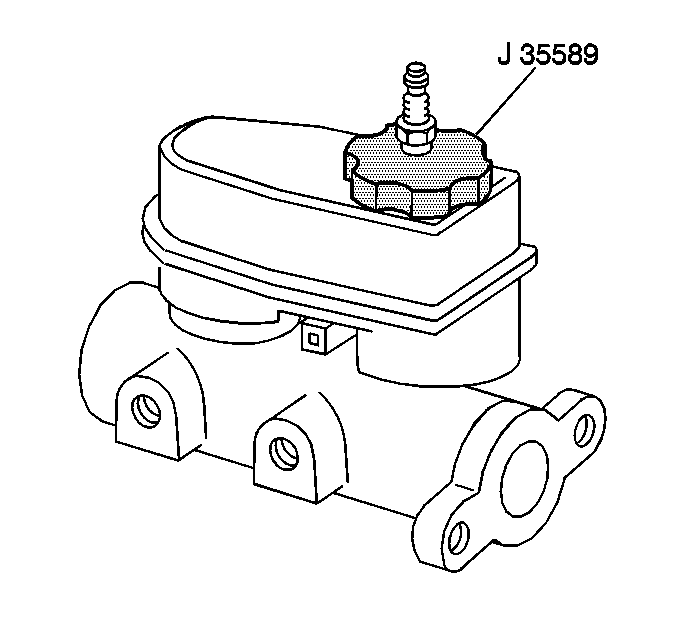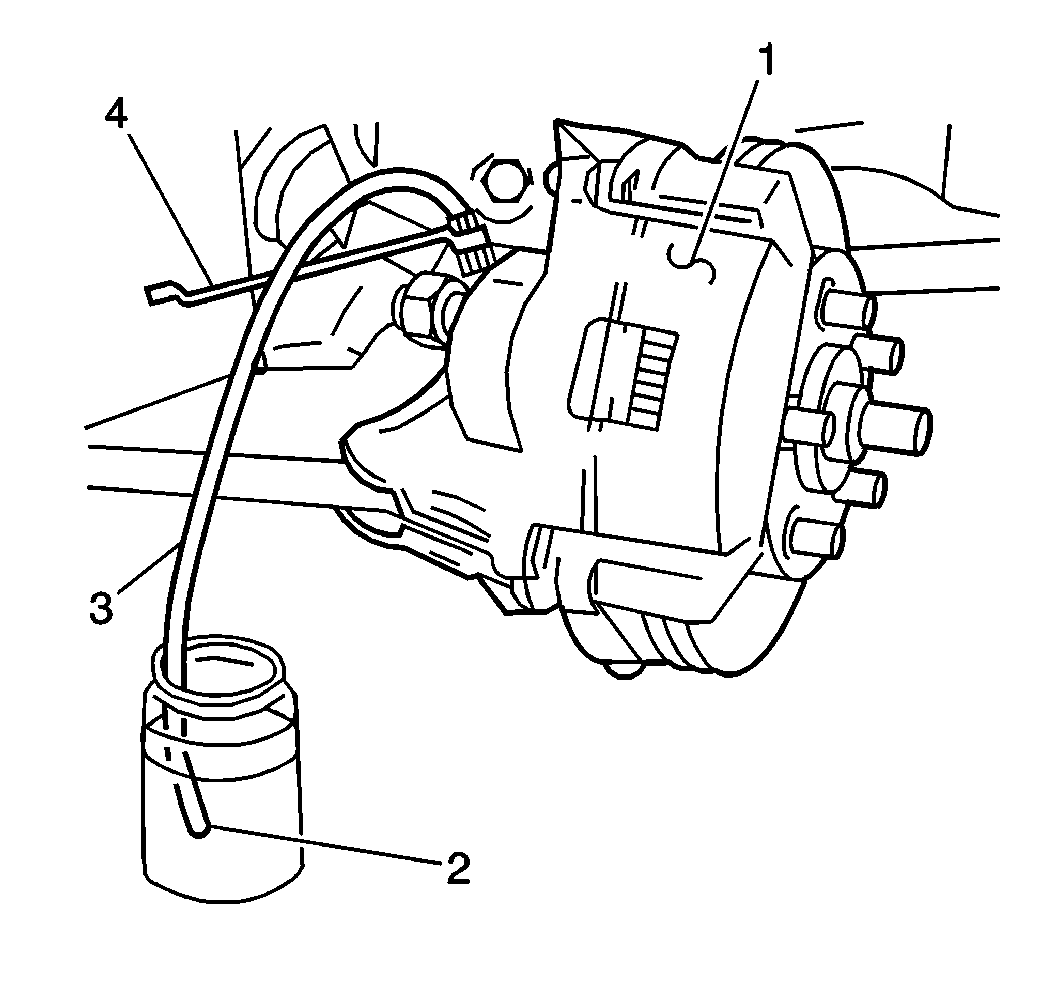Pressure Flushing
Tools Required
| • | J 29532 Diaphragm
Type Brake Bleeder |
| • | J 35589 Compact
Brake Bleeder Adapter |

Notice: Pressure Bleeding equipment can be used to perform the flush procedure.
The pressure bleeding equipment used for flushing must be of the diaphragm
type. It must a have a rubber diaphragm between the air supply and the brake
fluid to prevent air, moisture, and other contaminants from entering the hydraulic
system.
- Clean the brake fluid reservoir cover and the surrounding area.
- Remove the brake fluid reservoir cover.
- Remove any remaining brake fluid in the reservoir.
- Fill the brake fluid reservoir with clean brake fluid. Refer to
Master Cylinder Reservoir Filling
.
- Install the J 35589
to the brake fluid reservoir.
- Connect the J 29532
brake fluid hose to the bleeder adapter.
- Adjust the pressure bleeding equipment to 35-70 kPa
(5-10 psi) and wait for approximately 30 seconds in order
to ensure there is no leakage.
- Adjust the pressure bleeding equipment to 205-240 kPa
(30-35 psi).
- Raise and suitably support the vehicle. Refer to
Lifting and Jacking the Vehicle
in General Information.

- Flush the brakes in the
following sequence:
- Attach the bleeder hose (3) to the bleeder valve at each
wheel.
- Place the other end of the bleeder hose into a container (2)
in order to collect the draining brake fluid.
- Slowly open the bleeder valve and allow the fluid to flow.
Notice: Use the correct fastener in the correct location. Replacement fasteners
must be the correct part number for that application. Fasteners requiring
replacement or fasteners requiring the use of thread locking compound or sealant
are identified in the service procedure. Do not use paints, lubricants, or
corrosion inhibitors on fasteners or fastener joint surfaces unless specified.
These coatings affect fastener torque and joint clamping force and may damage
the fastener. Use the correct tightening sequence and specifications when
installing fasteners in order to avoid damage to parts and systems.
- Close the valve when clean brake fluid
begins to flow or at least 235 ml (8 oz) of fluid accumulates.
Tighten
- Tighten the front caliper bleeder valves to 13 N·m
(115 lb in).
- Tighten the rear caliper bleeder valves to 7 N·m
(62 lb in).
- Remove the bleeder adapter.
- Replace all of the following rubber components:
| • | The brake hose assemblies. |
| • | The master cylinder rubber parts. |
| • | The brake caliper seals. |
- Replace the brake pressure modulator valve. Refer to
Brake Pressure Modulator Valve Replacement
in Anti-Lock Braking System.
- Inspect the brake fluid level in the reservoir. Fill the reservoir
to the correct level if necessary.
- Install the brake fluid reservoir cap.
- Bleed the entire brake hydraulic system. Refer to
Hydraulic Brake System Bleeding
.
- Lower the vehicle.
Manual Flushing

Important: Use a suitable container and/or shop rags in order to catch fluid and
prevent the fluid from contacting any painted surfaces.
- Clean the brake fluid reservoir cover and the surrounding area.
- Remove the brake fluid reservoir cover.
- Remove any remaining brake fluid in the brake fluid reservoir.
- Fill the brake fluid reservoir with clean brake fluid. Refer to
Master Cylinder Reservoir Filling
.
- Install the brake fluid reservoir cover.
- Raise and suitably support the vehicle. Refer to
Lifting and Jacking the Vehicle
in General Information.

- Flush the brakes in the
following sequence:
- Attach the bleeder hose (3) to the bleeder valve at each
wheel.
- Place the other end of the bleeder hose into a container (2)
in order to collect the draining brake fluid.
- Slowly open the bleeder valve and allow the fluid to flow.
- Close the valve when clean brake fluid begins to flow or at least
235 ml (8 oz) of fluid accumulates.
Tighten
- Tighten the front caliper bleeder valves to 13 N·m
(115 lb in).
- Tighten the rear caliper bleeder valves to 7 N·m
(62 lb in).
- Replace all the following rubber components:
| • | The brake hose assemblies. |
| • | The master cylinder rubber parts. |
| • | The brake caliper seals. |
- Replace the brake pressure modulator valve. Refer to
Brake Pressure Modulator Valve Replacement
in Anti-Lock Braking System.
- Inspect the brake fluid level in the reservoir. Fill the reservoir
to the correct level if necessary.
- Install the brake fluid reservoir cap.
- Bleed the entire brake hydraulic system. Refer to
Hydraulic Brake System Bleeding
.
- Lower the vehicle.




